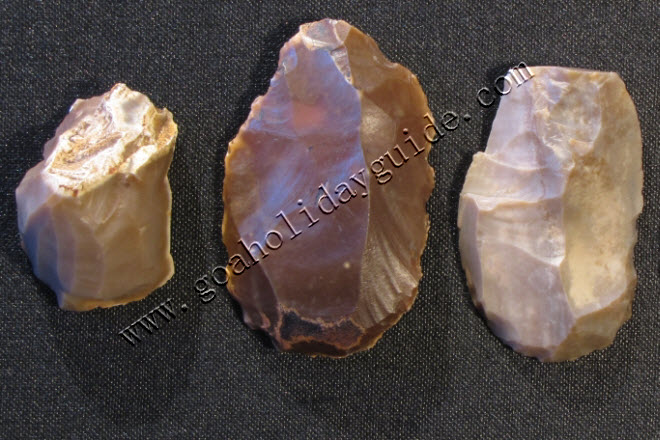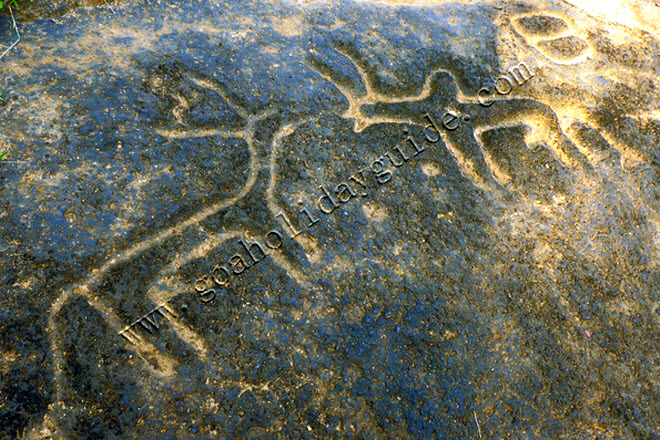Goa During The Paleolithic And Mesolithic Period
Geological History
Geologists concur that Goa was formed as a result of tectonic movements during the last Pleistocene age, when the bottom of Deccan plateau was lifted out of the sea to form the West-coast of India. This is supported by fossilized m
Mythological Origins
According to legend, Parashurama, the sixth reincarnation of Vishnu set seven arrows fly from the Sahydris to push back the sea and create a stretch of land. The sea-god is believed to have acceded his to wish and created a region Shurparaka, which translates literally to winnowing fan. Having created Goa, Parashurama is said to have settled Brahmins from the North in this land.
Paleolithic And Mesolithic Era
Light stone implements of the early stone age when man was essentially a hunter have been unearthed in the valleys of the Mandovi and Zuari, the two principal rivers of Goa, and the creeks and inlets that meet the sea at various points along the coast. Arrowheads, awls, scrapers of quartz found at Dabolim, Arli, reveal evidence of Goa's populational settlement in the middle stone age.
Blades, scrapers of siliceous material, which are tools of the later Stone Age, were found at Old Goa, Mopa and Kudnem. Incidentally Kudnem may perhaps indicate clues towards an ancient civilization that flourished in the area, on the basis of excavations carried out Polished stone axes stumbled upon at Old Goa were reportedly used by the first settlers of the land during the Neolithic period. These also had rock cut dwellings with the entrance hole at the top being closed by a stone slab.
Another important find that has provided evidence of the, existence of humans in Goa during the Paleolithic and Mesolithic period was the discovery of rock art engravings on lateritic platforms and granite boulders from Usgalimal on the banks of west-flowing river Kushavati river. The rock shelter at Usgalimal has enough space for 25 to 30 people. The perennial stream in the vicinity might have served the Stone Age man for centuries as a source of water. Anthropomorphic figures of Mother Goddess and tectiforms resembling tree-like motifs have also been found nearby.
The site was discovered by Dr. P.P.Shirodkar. Exploration of several Mesolithic sites of the Mandovi-Zuari basin, other sites at Keri, Thane, Anjuna, Mauxim, Kazur in Quepem, Virdi, has led to finding of several scrapers, points, bores, cones etc. A hand axe has also been found at Usgalimal. Further uni facial choppers were recovered on a flat-based pebble of quartzite from a pebble conglomerate at Shigaon on the river Dudhsagar. Shirodakar carried out a detailed study of the rock engravings and dated them to Upper Paleolithic and Mesolithic phase i.e. 20,000-30,000 BC. These historical discoveries have proved that well before the advent of agriculture, the region had been supporting a population of hunter-gatherers.
Paleolithic cave existence is seen at Dabolim, Adkon, Shirigao, Fatorpa, Arli, Maulinguinim, Diwar, Sanguem, Pilerne, Aquem-Margaon etc. Difficulty in carbon dating the laterite rock compounds poses problems in determination of exact time period.
Kushavati Shamanic Culture
Dr. Nandkumar Kamat from the University of Goa discovered the prehistoric petroglyphs of Goa. More than 125 forms were found scattered on the banks of river Kushavati in south-eastern Goa. According to Kamat, these are evidence of a prehistoric Goan shamanistic practice. For hundreds of years, the Kushavati rock art of Goa was known locally as goravarakhnyachi chitram, or pictures made by cowherds. But people did not know how ancient the works were, nor could anyone interpret them. After thorough study of these forms, scholars have concluded that these petroglyphs differ from those found elsewhere in Goa. Deeper studies and analysis over a period of ten years showed these petroglyphs were an exquisitely carved ocular labyrinth, one of the best in India and Asia. Its ocular nature added to the evidence of prehistoric shamanism.
The studies have shown that the Kushavati culture was a hunter-gatherer culture with deep knowledge of local natural resources and processes - water, fish, plants, game, animal breeding cycles, seasons and natural calamities. The Kushavati culture was greatly concerned with water security, so they set up camps near the streams. The Kushavati found food security in the jungle near the steam. Like every culture, its members confronted the mysteries of illness, death and birth. Kamat believes that this culture dated to 6,000 to 8,000 years ago.
On basis of recent DNA-based work on human migration, Dr. Nandkumar Kamat has ruled out the possibility of Kushavati shamans belonging to the first wave of humans to arrive in Goa. They were not Negritoes or Caustics. Most probably they were the earliest Mediterraneans who had descended the Western Ghats, probably in their search for sea salt on Goa’s coast. As the Kushavati transitioned into a Neolithic society, they began the domestication of animals and were in the last phase of using stone tools. The entire realm of shamanism underwent a radical transition. Today evidence of the metamorphosis in masked dance drama Perni jagor can be seen in the same cultural region.

